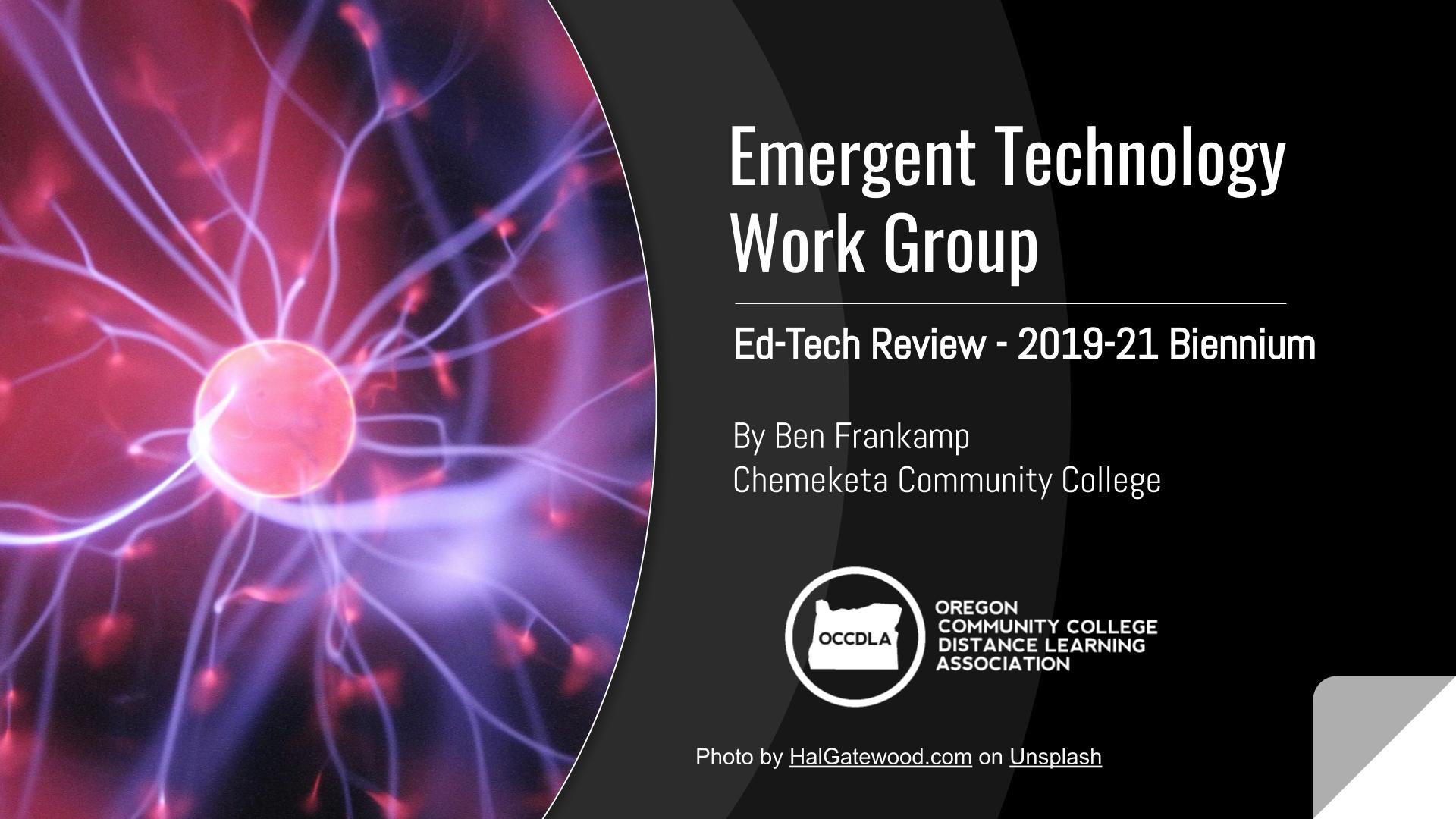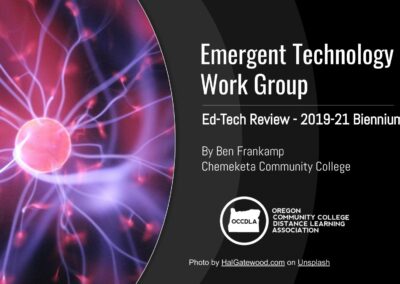EMERGENT TECHNOLOGY WORK GROUP - ED TECH REVIEWS
VR Experiences to Teach Chemical Polarity
by Ben Frankamp
Chemeketa Community College

Exploration Intent
The goal of this project was to create a Virtual Reality (VR) learning experience for college chemistry courses focused on the concept of chemical polarity. This learning experience was designed to take advantage of the unique manipulative environment of VR. The focus is to help students understand chemical polarity more deeply given the extremely small physical scale of chemical molecules. The experience was created in a framework called Unity using XR toolkit. The XR toolkit allows applications, games, meeting spaces etc. to be displayed and run on the vast majority of commercially available VR devices.
This experience is designed to augment the lecture/lab learning framework. Prior to this experience the students should have had a preliminary introduction to molecular shape, polarity of chemical bonds and dipole. The VR experience is a proving ground for the understanding, internalization, and generalization of these interconnected concepts.

Introduction to VR
The experience begins with a brief tutorial for students focused on familiarizing themselves to the VR environment specifically with regard to movement and interaction with the environment. Each of the four tutorial sections teaches students something important in terms of manipulating and understanding the polarity exercise to come. If a button or a menu in the user interface (UI) does something in the tutorial then it will do that exact thing in the experience. In this way the student is learning the ‘rules’ of the system by experience. From my perspective this interactive, experience-based learning environment is a fantastic framework to learn new and challenging concepts. Once the four tutorial sections are completed students are invited into the polarity experience.
Watch a video demo of this VR Experience.
Polarity Experience
The polarity experience has three sections: a place to retrieve a molecule, a place to ‘mark up’ a molecule, and a place to test the molecule (Figure 3). The first thing students will need is a molecule. Initially there are 15 molecules for students to choose from and they were chosen to have similarities in bond, shape and size but differ in polarity. Once students have a molecule they are asked to move over to the ‘mark up’ section of the experience. In this section students are prompted to add arrows in various colors to represent where bond polarities exist and where they might predict the molecule polarity (the dipole) would be. These arrows are drawn in VR in much the same way we would do it on paper but VR is three dimensional and the arrows are going to naturally contour to the three dimensional shape of the molecules. Students can rotate the molecule, walk around it, and investigate it from
all sides as they work.
Finally students are going to take their ‘marked up’ molecules over to the polarity track to test it. To do this a mechanism was written into the code of the project to apply the effect of an electronic field to the molecules. If you apply the field effect to the right, relative to the student’s view, the molecules that are polar should rotate to align with that field and move to the right. When the applied field is aligned to the left, the reverse is true. Molecules that are not polar will not move or rotate. This test doesn’t happen one molecule at a time. A track was built to receive three molecules and each of them will move independently, linked to their physically measured dipole value. Students can clear the track, grab three new molecules and try again to probe the concept further.

Project Insights
It was important to me that students were able to hold and manipulate molecules rather than move them with buttons or keyboard or mouse (Figure 4). While it is true that we are pushing a button on the controllers, what our brain ‘sees’ in VR is a hand grasping an object, in this case a molecule, and that object moving in the appropriate distance and speed and rotation of our hand: our brain thinks it’s a real object. This to me is critically important. If I’m on the street and ask a passerby if a baseball will fit into a garden hose the answer is instant and confident, no. Why do we have such certainty? Shouldn’t we encourage students to measure and collect data on the size of the ball relative to the size of the hose and justify the answer? Maybe, but that process is slow and cumbersome and our brain can do that for us if we feed it a set of experiences, like the physical manipulation of a baseball and a garden hose.

I want to feed my students a set of experiences that makes the understanding of a complicated behavior, chemical polarity, more intuitive. Intuition cannot supersede data, but neither should we throw it away as a learning objective. The difficulty is in how to teach it. Intuition is the product of experience coupled to keen observation. I can give my students a ‘physical’ interaction with molecules in VR that they cannot get in a traditional lab setting.
The traditional lab is abstract, learning about the molecules by observing behavior of many molecules. VR is much more concrete and specific. Once that experience is in place we can model and encourage the keen observation that makes those experiences useful as intuition.
Next Steps
The process of building an experience has been eye opening. In essence I have created a VR game. Video games have patches, which is a recognition that the work of developing an experience really never ends. Certainly when I get my first several dozen students through the experience I will have many improvements to make. I anticipate that streamlining the user experience and removing options will be a major component of that work. I want the experience to feel as comfortable as possible for my students.
As far as specific next steps, I would like to add the capability of multiple users in the same experience. This is not possible directly in Unity, for a variety of reasons, but is possible with several partner applications. The pacing and flexibility of a solo experience has value but the dynamic opportunity to teach each other and explain your thought process to others with shared goals is magic. When it happens in the classroom faculty members can just retreat a half step and let the room buzz with that energy. The addition of some framework to support a limited number of students, say 4 or 5, in a given instance of the experience would be a goal of mine as this project rolls out.
I would like to add the capability for students to create custom molecules. I considered this but in the end decided to focus on a limited number of molecules that can be combined to invite students to deeper understandings of polarity. One way that this is accomplished is by tying the behavior of the molecule in the experience to a physically measured value, the dipole. By tethering the way molecules interact in the VR environment to a physical value we find some surprising nonlinear behavior between molecules of similar structure. Even though I chose to not add a molecule building module in the game it would be a great addition and would open the scope of the project beyond its current boundaries, that is a good thing.
Finally I would like to acknowledge the folks and institutions that have helped make this project a reality. First, I would like to say thank you to Chemeketa for giving me the opportunity to pursue a sabbatical project. It is a unique and wonderful experience to focus your energy on a new thing for a period of time. I hope that as this project is rolled out that investment will be shared back to the students in my class, and the school in general, as other folks look to incorporate VR as a teaching tool. Within the institution I would like to say thanks to Marie Gabbard for encouragement to reach for a project that is exciting to me even if it is scary to propose. I would not be at this place without the encouragement and help of Sage Freeman who not only connected me with OCCDLA but also has pushed me to think more broadly about how this technology can be rolled into my classroom. I would like to thank the members of the OCCDLA for their support of this project by saying yes to a grant for me to purchase needed hardware for this project, specifically a laptop for coding and a VR headset. I would not have been able to make this project without Unity and they were gracious to provide a license free of charge during this work. On a personal note I would like to thank my brother, Josh, for his generosity and patience while answering so many coding questions and encouragement when I got stuck and frustrated.
2019-21 ED TECH REVIEWS
TECHNOLOGY EXPLORATION
Do you have an emergent technology you would like to explore? Submit your nomination for a technology evaluation by the OCCDLA Emergent Technology Workgroup.
The OCCDLA Emergent Tech Work Group receives nominations for instructional technology review from work group members and our nomination form, available to all instructors and administrative staff of all Oregon Community Colleges.
Questions?
For questions about the Emergent Technology Work Group:
Administrative Contact:
Monica Marlo
Portland Community College
monica.martinezgallagher@pcc.edu


